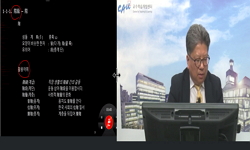이 글은 이른바 중국어의 표기 문자인 상용한자 3500자를 성조(tone) 부호가 표시된 한글로 어떻게 음절식 표기를 할 것인가에 대한 음운론적, 운율론적 연구의 결과물이다. 인간의 언어수행은...
http://chineseinput.net/에서 pinyin(병음)방식으로 중국어를 변환할 수 있습니다.
변환된 중국어를 복사하여 사용하시면 됩니다.
- 中文 을 입력하시려면 zhongwen을 입력하시고 space를누르시면됩니다.
- 北京 을 입력하시려면 beijing을 입력하시고 space를 누르시면 됩니다.
https://www.riss.kr/link?id=A105214760
- 저자
- 발행기관
- 학술지명
- 권호사항
-
발행연도
2017
-
작성언어
Korean
- 주제어
-
자료형태
학술저널
-
수록면
279-305(27쪽)
- 제공처
- 소장기관
-
0
상세조회 -
0
다운로드
부가정보
국문 초록 (Abstract)
이 글은 이른바 중국어의 표기 문자인 상용한자 3500자를 성조(tone) 부호가 표시된 한글로 어떻게 음절식 표기를 할 것인가에 대한 음운론적, 운율론적 연구의 결과물이다. 인간의 언어수행은 시간적으로 연속된, 의미를 띤 심리적 음절에 운소가 얹혀 이 음절들이 분할되면서 뫼비우스띠 형상을 한 물리적 운율을 형성하는 것이라고 가정해 볼 때, ‘한글운율문법’은 복층(2층)구조화되어있는 이 세상 7,000종 모든 언어의 1층의 음절들은 ‘한글’ 문자(훈민정음)로 음절식 표기를 하고, 2층의 운율은 오선지 위에 음표 및 쉼표로 표시할 수 있는 새 언어이론이라고 할 수 있겠다. 이 ‘한글운율문법’ 이론에 따라, 성조언어인 중국어의 한자들을 한글로 ‘형태음소적 음절표기’를 하고, 성조가 얹혀서 분할된 이 물리적 음절들(음소적 음절표기)이 이루는 운율의 정보를 오선지 위에 음표를 그려 제공함으로써 우리 한국인들이 중국어를 빠른 시간 안에 잘 습득할 수 있는 길이 열리게 되었다.
다국어 초록 (Multilingual Abstract)
King Sejong"s Korean alphabet (Hangul Unicode (Hangul Jamo)) can accurately, syllabically transcribe all estimated seven thousand languages in this world used by its 7.4 billion population. In this thesis my "tone coded Hangul" text can perfectly tran...
King Sejong"s Korean alphabet (Hangul Unicode (Hangul Jamo)) can accurately, syllabically transcribe all estimated seven thousand languages in this world used by its 7.4 billion population. In this thesis my "tone coded Hangul" text can perfectly transcribe the 3500 Chinese Characters. We can use the "Hangul Prosody" as a basis for new education reforms. Reforms will include "restructuring of foreign language education in schools," "revolutionary education methodology, and "periodic training of teachers on using the new instruction methods." Hangul Prosody: 1) First Hangul Rhythm Law-Speech sound combines with vowel phonemes which have long pronunciation times, and consonant phonemes which have short pronunciation times to create 4 types of beat syllables: 1. V type (vowel only). 2. CV type (consonant + vowel). 3. VC type (vowel + consonant) 4. CVC type (consonant + vowel + consonant). The combination of these short-sounding consonants and longer-sounding vowels to create the "beat syllable" is the First Hangul Rhythm Law. 2) Second Hangul Rhythm Law-Vowels and consonants make up the syllable, which acts as the beat. The syllable then physically coordinates with other syllables to create Times of longer time lengths. This process is the Second Hangul Rhythm Law. 3) Third Hangul Rhythm Law-Beat syllables are imbued with semantic functions such as accent, tone, length, and feature. Beat syllables of equal Time lengths gather in one"s, two"s, three"s, four"s... ten"s in a process called "grouping." Grouping creates natural physical sounds leading into "melody rhythm intonation". This overall process is called the Third Hangul Rhythm Law.
목차 (Table of Contents)
- 〈한글요약문〉
- 1. 서론
- 2. 유니코드한글자모(UnicodeHangul Jamo)로중국어표기하기
- 3. 한국어 및 중국어의 음운체계
- 4. ‘온누리한글 중국어’ 음절표
- 〈한글요약문〉
- 1. 서론
- 2. 유니코드한글자모(UnicodeHangul Jamo)로중국어표기하기
- 3. 한국어 및 중국어의 음운체계
- 4. ‘온누리한글 중국어’ 음절표
- 5. 중국어 상용한자 3500자의 한글 표기 용례
- 6. 결론
- [참고문헌]
- Abstracts
동일학술지(권/호) 다른 논문
-
- 충남대학교 충청문화연구소
- 방문정(Pang, Wenting)
- 2017
-
- 충남대학교 충청문화연구소
- 황인덕(Hwang, In-deok)
- 2017
-
- 충남대학교 충청문화연구소
- 이전오(Lee, Jeon-oh)
- 2017
-
- 충남대학교 충청문화연구소
- 이향배(Lee, Wyhang-bae)
- 2017




 RISS
RISS DBpia
DBpia







